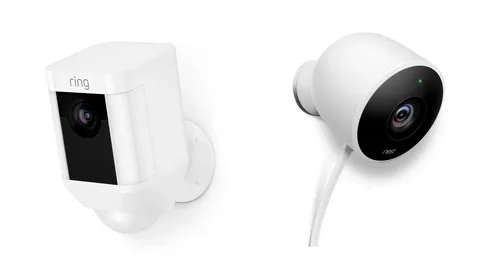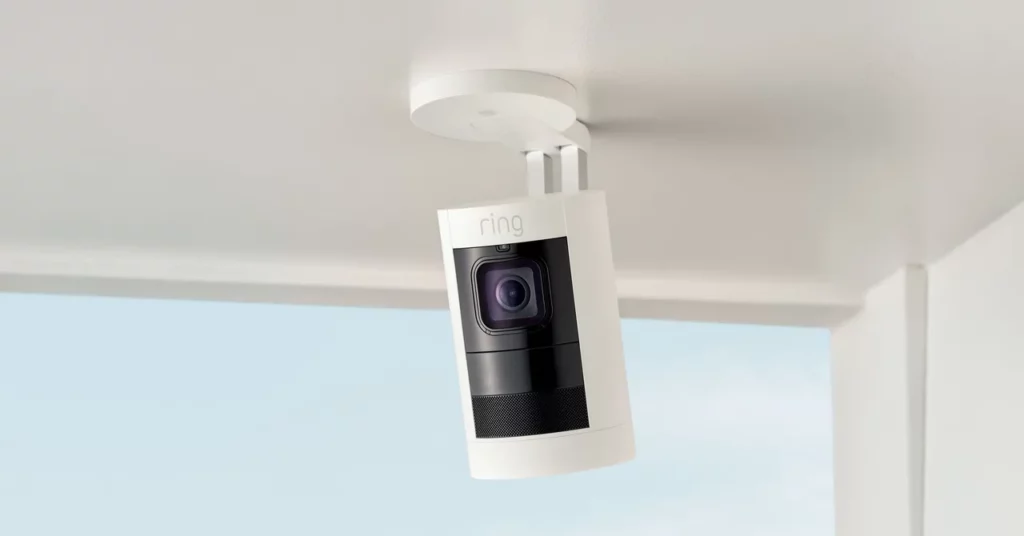Introduction
In recent years, home security has witnessed a significant revolution with the advent of smart surveillance devices, and the Ring camera is at the forefront of this technological transformation. Offering a versatile and convenient solution, Ring cameras have become increasingly popular among homeowners seeking to monitor their properties remotely. One of the crucial aspects of these cameras is the lifespan of their batteries, as it directly impacts their usability and effectiveness.
The longevity of Ring camera batteries is a multifaceted topic that depends on various variables. First and foremost, the camera model plays a vital role in determining battery life. Different Ring camera models come equipped with varying battery capacities, and as a result, their longevity may differ significantly. Additionally, factors such as camera usage frequency, the number of motion-triggered recordings, and the camera’s operating environment can impact battery performance.
Extreme weather conditions, such as excessive heat or cold, may affect battery efficiency, leading to shorter lifespans. Furthermore, user habits and settings configuration also play a crucial role. Adjusting motion sensitivity, video quality, and the frequency of live-viewing sessions can have a direct impact on battery consumption. By optimizing these settings, users may extend their Ring camera’s battery life and minimize the need for frequent recharging or battery replacement.

How long will a battery last in a Ring camera?
Six to twelve months
The battery should last six to twelve months and should take five to ten hours to recharge, depending of course on usage. Or, if you want to be as environmentally friendly as possible, you can use solar power with your Ring Stick Up Cam Battery.
The longevity of a battery in a Ring camera varies depending on several factors, including the model of the camera, usage patterns, environmental conditions, and user settings. Ring offers a range of camera models, each with different battery capacities, which directly impacts how long the battery will last.
Generally, newer Ring camera models come equipped with improved battery technology and more efficient power management systems, leading to extended battery life compared to earlier versions. The company continually strives to enhance its products, aiming to provide users with longer-lasting batteries and better overall performance.
Usage patterns also play a crucial role in determining how long a Ring camera battery will last. Cameras that experience frequent motion-triggered recordings or live-view sessions will consume more power and, consequently, have shorter battery life. On the other hand, cameras set up in less active areas or with lower sensitivity may experience less frequent battery drainage.
Why is my Ring battery draining so fast?
Lots of Activity. The more events captured by your Ring devices, the more your battery is used. Using Live View often can also drain your battery faster.
If you find that your Ring battery is draining faster than expected, several factors could be contributing to this issue. Understanding the potential causes will help you identify and address the problem effectively.
High Usage and Motion Activations: If your Ring camera is in an area with constant motion or excessive activations, it will drain the battery faster. Frequent motion-triggered recordings and live-viewing sessions can significantly impact battery life.
Poor Wi-Fi Signal Strength
A weak Wi-Fi signal can cause the camera to use more power as it struggles to maintain a stable connection. When the camera’s Wi-Fi signal is weak, it may continuously attempt to reconnect, leading to increased battery consumption.
Extreme Weather Conditions
Exposure to extreme temperatures, especially excessive heat, can adversely affect battery performance. High temperatures can accelerate battery drain and reduce its overall lifespan.
Outdated Firmware and Software
Ensuring your Ring camera has the latest firmware and software updates is crucial. Manufacturers often release updates that include performance optimizations and bug fixes, which can help improve battery efficiency.
High Video Quality Settings:
Using high video quality settings can consume more power as it requires more processing and data storage. Lowering the video quality or adjusting the recording duration can help conserve battery power.
Do Ring batteries wear out?
Batteries in Ring devices are designed to go months between charges under normal conditions. However, real battery life is dependent on a number of factors such as local weather, number of events captured, and frequency of activation.
Yes, like any rechargeable battery, Ring camera batteries do wear out over time. Rechargeable batteries have a limited lifespan, and their capacity to hold a charge gradually diminishes with use and age. As a result, you may notice that the battery life of your Ring camera becomes shorter over the months or years of usage.
The rate at which Ring camera batteries wear out can vary depending on several factors:
Charge and Discharge Cycles
The more you recharge and discharge the battery, the more it wears out. Each complete charge cycle refers to the process of using the battery from 100% to 0% and then recharging it to 100%. The number of charge cycles a battery can endure before its capacity significantly decreases depends on the battery’s chemistry.
Usage Patterns
Frequent and demanding usage, such as constant motion-triggered recordings or live-viewing, can accelerate battery wear. Cameras in high-activity areas may experience more charge cycles, leading to faster battery degradation.
Environmental Conditions
Exposure to extreme temperatures, particularly excessive heat, can affect battery health and accelerate wear. Extremely cold temperatures can also temporarily reduce battery capacity.
Charging Habits
Charging the battery too frequently or leaving it at 0% for extended periods can have an impact on its overall health.
Battery Quality
The quality and manufacturing of the battery itself can also influence its lifespan. High-quality batteries generally last longer than cheaper alternatives.

Do Ring batteries overcharge?
In rare cases, lithium-ion batteries can overheat, catch fire, or explode. A lithium-ion battery can fail due to the following: Overcharging: an overcharged battery can rupture, overheat, catch fire, or explode. Extreme temperatures: extreme cold and heat can affect battery charging.
Ring batteries are designed with safety features to prevent overcharging. When you connect your Ring camera or doorbell to its charging cable, the battery management system ensures that the battery stops charging once it reaches its full capacity. This prevents overcharging and helps protect the battery from potential damage.
The charging process is carefully managed by the device’s internal electronics, which monitor the battery’s voltage and temperature. When the battery reaches its full charge level, the charging process is automatically halted. Modern lithium-ion batteries, such as those used in Ring devices, are equipped with built-in safeguards to prevent overcharging, over-discharging, and overheating.
It is essential to use the official Ring charging cable or the recommended accessories provided by the manufacturer to ensure the proper functioning of these safety features. Using third-party charging cables or incompatible power sources could potentially compromise the battery’s safety mechanisms.
How can I extend my Ring battery life?
Follow these tips to get the most out of your ring’s battery life.
- Charge Your Ring Before Going to Bed.
- Enable Airplane Mode.
- Enable Low Battery Notifications.
- Prevent Damage to Your Battery.
- Properly Store Your Ring.
- Only Use Your Ring with One Device.
- More Information.
Extending the battery life of your Ring camera or doorbell is essential to ensure continuous and reliable surveillance of your property. By implementing a few practical tips, you can maximize the efficiency of your Ring device and prolong its battery life:
Optimize Motion Settings
Adjust the motion sensitivity and detection zones to reduce unnecessary activations. By fine-tuning these settings, you can minimize the frequency of motion-triggered recordings, conserving battery power.
Reduce Live-View Sessions
While live-viewing is convenient, excessive use can drain the battery quickly. Limit live-view sessions to when you genuinely need them to conserve battery life.
Lower Video Quality
Higher video quality settings consume more power as they require more data processing and storage. Consider using lower video quality settings if high resolution is not essential for your needs.
Utilize Motion Scheduling
Some Ring devices offer motion scheduling features. Use this option to disable motion alerts during certain hours when you don’t require surveillance, such as when you’re at home.
Opt for Solar Panels or Wired Connection
If possible, connect your Ring device to a solar panel or a wired power source. This ensures a continuous power supply, reducing reliance on the battery.
Maintain Wi-Fi Signal Strength
A weak Wi-Fi signal can cause the camera to consume more power as it attempts to maintain a stable connection. Ensure your device is positioned within a good Wi-Fi range.
Regular Firmware Updates
Keep your Ring device’s firmware up to date. Manufacturers often release updates that include performance optimizations, which can improve battery efficiency.
Do Ring camera batteries go bad?
According to Ring, the battery in a Ring video doorbell should last between 6 and 12 months before it needs to be recharged. That estimate is based on ideal environmental conditions, though, and likely doesn’t consider the sort of high use some users may experience with their Ring doorbells.
Yes, Ring camera batteries can go bad over time. Like all rechargeable batteries, the batteries used in Ring cameras have a limited lifespan and will eventually degrade with use. As a battery undergoes numerous charge and discharge cycles, its ability to hold a charge gradually diminishes, leading to a reduction in battery life and performance.
Several factors can contribute to the deterioration of Ring camera batteries:
Charge and Discharge Cycles: Each complete charge cycle, from 100% to 0% and back to 100%, contributes to battery wear. The number of charge cycles a battery can endure before its capacity decreases significantly depends on the battery chemistry.
Usage Patterns: Frequent motion activations, live-view sessions, and high video quality settings can lead to more charge cycles, accelerating battery degradation.
Environmental Conditions: Exposure to extreme temperatures, particularly excessive heat, can adversely affect battery health and speed up degradation.
Charging Habits: Overcharging or regularly allowing the battery to fully discharge can also impact its overall health and lifespan.
Battery Age: Over time, even with careful usage, the battery’s capacity will naturally decline.
While Ring camera batteries do go bad eventually, the rate at which this happens depends on how the camera is used, the quality of the battery, and the surrounding environmental conditions. However, with proper care and maintenance, you can extend the life of your Ring camera battery and optimize its performance.
Is it OK to leave Ring battery on charger?
Can I leave the Battery Packs in the Charging Station even after they’re fully charged? Yes. If you have a Quick Release Battery Pack always charged you can be sure your Ring Video Doorbell is never down.
Let your Ring camera battery charge for a while—it won’t hurt. Overcharging protection is built into Ring camera batteries. To prevent battery damage, charging stops when the battery is full.
You can keep the Ring battery on the charger, but don’t leave it for too long, especially after it’s fully charged. As with any lithium-ion battery, frequent and long charging sessions may cause some capacity loss.
Consider these ways to extend the life and efficiency of your Ring camera battery:
Ring camera batteries should be disconnected from the charger after full charge. This prevents overcharging and enhances battery life.
Avoid Over-Discharging: Emptying the battery might also shorten its lifespan. Before the battery dies, charge it.
Always use the official Ring charging cable or manufacturer-recommended accessories. Third-party charging cables may jeopardize battery safety.
Optimize Charging Habits: Charge the battery as needed, but don’t leave it on the charger, especially if it’s full.
Update your Ring camera’s firmware regularly. Manufacturer upgrades often optimize performance, improving battery economy.
Connecting your Ring camera to a solar panel or cable power source can provide continuous electricity without relying on the battery.
How long do rechargeable batteries last?
Between two and five years
What are the Advantages of Rechargeable Batteries? Rechargeable batteries typically last between two and five years and can be recharged hundreds of times. While they cost more than alkaline batteries, they last longer per use than alkaline batteries and end up saving you money in the long run.
The lifespan of rechargeable batteries varies depending on several factors, including the type of battery, usage patterns, charging habits, and environmental conditions. Rechargeable batteries are available in various chemistries, such as lithium-ion (Li-ion), nickel-metal hydride (NiMH), and nickel-cadmium (NiCd). Each type has different characteristics that influence their longevity.
Lithium-Ion (Li-ion) Batteries
Li-ion batteries are commonly used in modern electronics, including smartphones, laptops, and many other portable devices. On average, Li-ion batteries can last for 2 to 3 years or around 300 to 500 charge cycles before their capacity significantly decreases. High-quality Li-ion batteries may last even longer.
Nickel-Metal Hydride (NiMH) Batteries
NiMH batteries are often found in devices like digital cameras, toys, and some power tools. They typically have a lifespan of around 2 to 5 years or approximately 500 to 1000 charge cycles.
Nickel-Cadmium (NiCd) Batteries
NiCd batteries are becoming less common due to environmental concerns, but they can still be found in older devices. Their lifespan is typically around 2 to 5 years or approximately 500 to 1000 charge cycles.
The number of charge cycles a battery can endure before capacity decline varies based on how deeply the battery is discharged with each cycle. Shallower discharges (e.g., from 20% to 80%) are less stressful on the battery and can prolong its life compared to deeper discharges (e.g., from 0% to 100%).

Conclusion
The lifespan of Ring camera batteries is a crucial consideration for homeowners looking to maintain an efficient and reliable home surveillance system. As we have explored, the duration of battery life is influenced by various factors, including the camera model, usage frequency, environmental conditions, and user settings. Being aware of these variables empowers users to make informed decisions to optimize their Ring camera’s battery performance.
Ring’s commitment to innovation and technology has led to continuous improvements in battery efficiency and longevity over the years. As the company introduces newer camera models, users can expect advancements in battery technology, leading to longer-lasting power sources. To ensure extended battery life, users can adopt several best practices. Adjusting motion sensitivity and optimizing video quality can reduce unnecessary activations and conserve power.
Regularly updating the camera’s firmware and software also helps ensure it operates at its most efficient capacity. Furthermore, considering the operating environment is crucial. Placing the camera in moderate temperatures and protecting it from extreme weather conditions can significantly impact battery performance. Utilizing Ring’s solar panel or purchasing spare batteries to swap out when needed can also provide a continuous power source.

